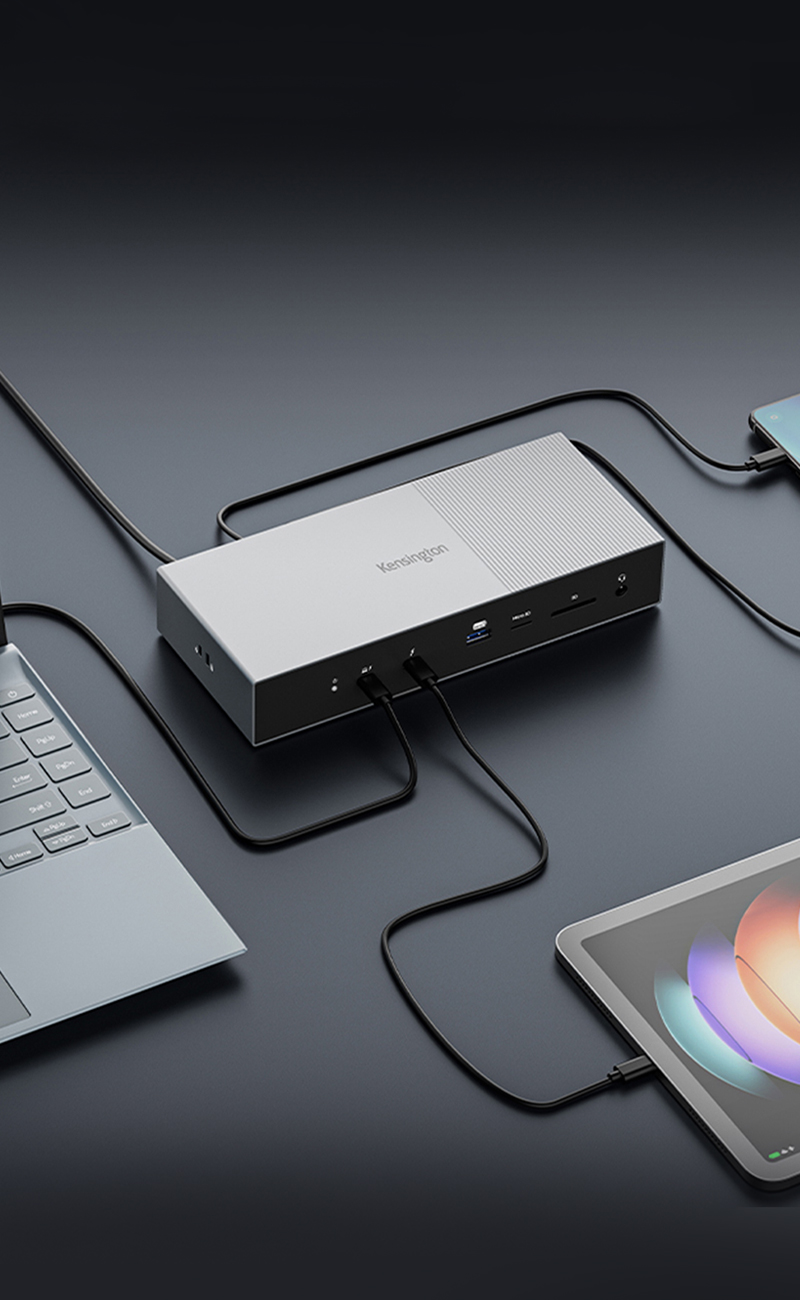
What do IT professionals think about docking station challenges, hot desking, and upcoming tech trends? Kensington wanted to put a finger on the pulse of IT docking experiences, so we commissioned a research study with Spiceworks to ask IT admins about their current workplace practices and future predictions. The 450 respondents who qualified to take the survey were all IT decision-makers who influenced choices about docking stations at organizations with 50-999 employees. Now, the numbers have been crunched. The responses have been analyzed. The results have been assembled. Let’s take a look at what IT professionals really think about the present and future of docking, organization environments, and more!

IT Pros Anticipate Shifts in Docking Standards and Usage
It’s always handy to gain insight into how other organizations approach something like docking. IT decision-makers reported that a majority of organizations are currently using—and prefer—OEM mechanical docks, though larger organizations with 500-999 employees had a higher use and preference for USB 3.0 docking stations. That’s the standard today, but what about tomorrow’s docking connector? USB-C is seen as the most likely to “win out” as the standard docking connector in the future, while only about 1 in 10 respondents expect Thunderbolt connectors to be the go-to for future docking needs.

Respondents anticipate a shift in the type of docks used as well. IT admins report that, on average, proprietary docks make up about half the docking stations at their organizations, but they expect their use of proprietary docks to decrease in the next year to be replaced with more universal docks. Why the anticipated change from proprietary to universal? Perhaps because of the next finding…

Multiple Laptop Brands and Hot Desking Pose a Challenge for IT Admins
Instead of a one-computer-fits-all approach, today’s organizations frequently support a mixture of laptop brands. Dell makes up the largest proportion of laptops at organizations of all sizes, although larger organizations tend to have a more evenly spread mix of laptop brands including Apple and Microsoft. The majority of devices are desktops (50% overall) and laptops (37% overall), with tablets and 2-in-1 devices making up a much smaller percentage. With the pervasiveness of mixed computer environments, it’s no surprise that compatibility and end-user issues rise to the top of the reported challenges with docking.

Hot desking and hoteling, though not currently practiced in high numbers in the United States (but rapidly growing in Europe), creates an additional challenge for IT professionals. On average, less than a quarter of organization workplaces are currently hot desked, though about a third of respondents expect their use of hot desking to increase in the coming year. IT admins saw end-user issues to be the greatest challenge related to hot desking, particularly due to a lack of employee accountability. For IT decision-makers in multiple computer environments—and especially in hot desking workplaces—the right dock needs to remedy docking compatibility and end-user challenges.

New Technology Has Tremendous Potential—After Thorough Vetting
When it comes to attitudes toward emerging technology, some seek out the very cutting-edge, others are cautiously curious about new tech, and still others prefer to stick with the tried and true. Fittingly, most IT professionals fall into the early majorityof technology adoption, identifying a need for information, demonstrations, and trusted reviews before fully embracing new products or services.
Desire for Trial Periods:
"Being provided for free, fully functional sample products to test in my environment."
One in four IT decision-makers at larger organizations prefer to be first in line to try out the newest products, excited to implement emerging tech solutions that will increase efficiencies and benefit end-users.
Enthusiasm for Tech's Increasing Efficiency:
"Adding efficiency to the users' day without increasing complexity."
Those less eager to embrace new tech cite concerns about product dependability, quality, and compatibility.
Concerns about Tech Longevity & Compatibility:
"How it will work with our company."
So, if the majority of IT professionals prefer to gather information before implementing a new product or service for their organization, what resources and criteria do they use?
When Purchasing a New Dock, Researching Compatibility is Crucial
When IT decision-makers prepare to purchase new docking stations, research is key. To learn about new docks, IT pros report that they rely most often on internet searches, information from laptop vendors or manufacturer websites, and IT forums and blogs. Dock compatibility is seen as the most important factor when selecting a new dock, along with product specs and pricing. When it’s time to purchase the docking station, buying through a reseller, direct from the laptop manufacturer, or vie e-commerce sites are preferred. These are the most common purchasing practices of IT decision-makers—how similar or different are your go-to strategies?

Kensington’s docking survey gives us a closer look at how IT pros view their workplace needs, emerging technology adoption, and docking purchase processes. Now that you know more about perceptions of current practices and future expectations, you’re armed with information that could help you select the right docking station to meet your organization’s needs.
View our full portfolio of award winning docking stations today to find the ideal fit for your workplace environment! If you’ve got questions about docking, shoot us an email at dockguy@kensington.com for help with selecting your organization’s perfect docking solution. Because organizations want to be sure a new technology works with their environment before fully investing in it, Kensington created the ProConcierge program to allow you to try our docking stations, with no obligation to buy. Apply for the ProConcierge Program today and let Kensington take the complexity out of docking.
